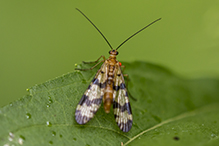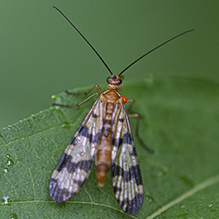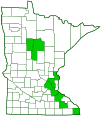Helena’s scorpionfly
(Panorpa helena)
Conservation • Description • Habitat • Ecology • Distribution • Taxonomy
Conservation Status |
|||
| IUCN Red List | not listed |
||
| NatureServe | NNR - Unranked |
||
| Minnesota | not listed |
||
Description |
Helena’s scorpionfly is the most abundant and widely distributed common scorpionfly of the genus Panorpa in North America. However, it does not occur in the west, it is absent from Quebec, and it is uncommon in Ontario. The body is soft, slender, cylindrical, and ⅜″ to 1″ long. The upper plate covering the thorax (pronotum) has an orangish tint. The abdomen is slender and has 10 segments. On the male, segments 2 through 5 are pale brown, 6 through 9 are orangish brown. The male genitalia on segment 10 are large, bulbous, pear-shaped, and curved upward and forward. They are similar in appearance to a scorpion’s stinger. The female abdomen is similar to the male but tapers to a blunt point and lacks the stinger-like genitalia on segment 10. The legs are long, slender, and pale brown. At the end of the leg the part corresponding to the foot (tarsus) has five segments (tarsi) and two claws. The tarsi are blackish at the end (apex). The head is orangish-brown and extremely elongated downward, snout-like, ending in biting mouthparts. The neck is distinct. The compound eyes are large, well-developed, and silvery gray. The antennae are thread-like, black, and long, more than half as long as the body, and have at least 14 segments. The four wings are long, narrow, membranous and yellowish. Forewings and hindwings are about the same size. They have numerous veins and cross veins; three dark brown bands, apical, pterostigmal, and basal; and three dark brown spots. The apical and pterostigmal bands are continuous. The basal band is usually continuous, sometimes broken. There is a small spot on the margin in the clear area separating each band, and one small basal spot. The larvae resemble small caterpillars, with eight short leg-like structures (prolegs) and numerous hair-like growths (setae). |
Size |
Total length: ½″ to 1″ Wingspan: up to 1⅛″ |
Similar Species |
Habitat |
Moist areas with dense low shrubbery, especially deciduous woods and adjacent open areas |
Ecology |
Season |
May to September |
Behavior |
They are usually found standing on leaves in a shaded area less than one meter from the ground. Despite the male’s fierce appearance, scorpionflies do not sting or bite. |
Life Cycle |
Eggs are laid in masses on the ground. Larvae live in burrows in the ground, coming out only to hunt for insect prey. They overwinter in underground cells as pupae. Adults emerge in May. |
Larva Food |
Organic matter and insects. |
Adult Food |
Mostly dead or dying insects, sometimes taken from a spider’s web; sometimes fruit or nectar |
Distribution |
||
|
Sources Biodiversity occurrence data published by: Minnesota Biodiversity Atlas (accessed through the Minnesota Biodiversity Atlas Portal, bellatlas.umn.edu, XX/XX/XXXX). |
|
| 9/3/2025 | ||
Occurrence |
||
Common and widespread in eastern North America |
||
Taxonomy |
|
Order |
Mecoptera (Scorpionflies, Hangingflies, and Allies) |
Family |
Panorpidae (Scorpionflies) |
Subfamily |
Panorpinae |
Genus |
Panorpa |
Subordinate Taxa |
|
|
|
Synonyms |
|
|
|
Common Names |
|
Helena’s scorpionfly |
|
Glossary
Pronotum
The exoskeletal plate on the upper side of the first segment of the thorax of an insect.
Proleg
A fleshy structure on the abdomen of some insect larvae that functions as a leg, but lacks the five segments of a true insect leg.
Pterostigma
The dark, blood-filled second cell at the leading edge of each wing toward the tip on many insects. It is heaver than adjacent, similar sized areas and is thought to dampen wing vibrations and signal mates. (= stigma. More precise than stigma but less often used, even by entomologists.)
Pupa
The life stage of some insects undergoing transformation. In caterpillars, the chrysalis. Plural: pupae.
Seta
A usually rigid bristle- or hair-like outgrowth on butterflies and moths used to sense touch. Plural: setae.
Tarsus
On insects, the last two to five subdivisions of the leg, attached to the tibia; the foot. On spiders, the last segment of the leg. Plural: tarsi.
Identification
Positive identification of common scorpionflies usually involves dissection and examination of the male genitalia under a microscope. However, wing markings are also useful. For a plate showing wing markings of twelve Panorpa species, see Mecoptera of Ontario, Wings Ontario species of Panorpa.
Visitor Photos
Share your photo of this insect.
This button not working for you?
Simply email us at info@MinnesotaSeasons.com.
Attach one or more photos and, if you like, a caption.
|
||
MinnesotaSeasons.com Photos
 |
 |
|

Slideshows

Visitor Videos
Share your video of this insect.
This button not working for you?
Simply email us at info@MinnesotaSeasons.com.
Attach a video, a YouTube link, or a cloud storage link.
Other Videos
Invertebrate Short Clips: Panorpa helena
Daily Entomologist

Visitor Sightings
Report a sighting of this insect.
This button not working for you?
Simply email us at info@MinnesotaSeasons.com.
Be sure to include a location.
Minnesota Seasons Sightings


